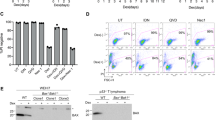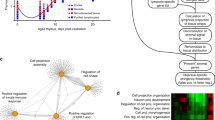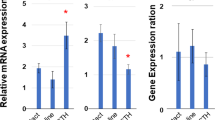Abstract
The glucocorticoid receptor binding capacity of rat thymus cells disappears when the cells are depleted of ATP by anaerobiosis, and rapidly reappears when ATP levels are restored1–3. Loss and recovery of binding capacity occurs even when protein synthesis is suppressed with cycloheximide3,4. In view of this and similar work in other cell systems5,6, we proposed that in cells deprived of ATP the receptor is present in a form—the ‘null receptor’ form, as we shall call it—that cannot bind hormone4. Although many subsequent observations support this idea, no direct evidence has appeared for the existence of the null receptor. We have attempted to detect the null receptor in WEHI-7 mouse thymoma cells with a monoclonal antibody to the glucocorticoid receptor. Here we report that the null receptor is bound in the nuclei of ATP-depleted cells, and is present in amounts comparable to those of receptors in normal cells.
This is a preview of subscription content, access via your institution
Access options
Subscribe to this journal
Receive 51 print issues and online access
$199.00 per year
only $3.90 per issue
Buy this article
- Purchase on Springer Link
- Instant access to full article PDF
Prices may be subject to local taxes which are calculated during checkout
Similar content being viewed by others
References
Munck, A. & Brinck-Johnsen, T. Excerpta Med. Int. Congr. Ser. 132, 472–481 (1967).
Munck, A. & Brinck-Johnsen, T. J. biol. Chem. 243, 5556–5565 (1968).
Bell, P. A. & Munck, A. Biochem. J. 136, 97–107 (1973).
Munck, A. et al. J. Steroid Biochem. 3, 567–578 (1972).
Chader, G. J. J. Neurochem. 21, 1525–1532 (1973).
Wheeler, R. H. et al. J. biol. Chem. 256, 434–441 (1981).
Govindan, M. V. Expt Cell Res. 127, 293–297 (1980).
Antakly, T. & Eisen, H. J. Endocrinology 115, 1984–1989 (1984).
Welshons, W. V., Krummel, B. M. & Gorski, J. Endocrinology 117, 2140–2147 (1985).
Mendel, D. B., Bodwell, J. E., Gametchu, B., Harrison, R. W. & Munck, A. J. biol. Chem. 261, 3758–3763 (1986).
Sadowski, P. D. & Steiner, J. J. Cell Biol. 37, 147–161 (1968).
Housley, P. R., Grippo, J. F., Dahmer, M. K. & Pratt, W. B. Biochem. Actions Horm. 11, 347–376 (1984).
Rossini, G. P. J. theor. Biol. 108, 39–53 (1984).
Bourgeois, S. & Gasson, J. C. Biochem. Actions Horm. 12, 311–351 (1985).
Northrop, J. P., Gametchu, B., Harrison, R. W. & Ringold, G. M. J. biol. Chem. 260, 6398–6403 (1985).
Stanely, P. E. & Williams, S. G. Analyt. Biochem. 29, 381–392 (1969).
Khym, J. X. Clin. Chem. 21, 1245–1252 (1975).
Munck, A. & Wira, C. Meth. Enzym. 36, 255–264 (1975).
Gametchu, B. & Harrison, R. W. Endocrinology 114, 274–279 (1985).
Author information
Authors and Affiliations
Rights and permissions
About this article
Cite this article
Mendel, D., Bodwell, J. & Munck, A. Glucocorticoid receptors lacking hormone-binding activity are bound in nuclei of ATP-depleted cells. Nature 324, 478–480 (1986). https://doi.org/10.1038/324478a0
Received:
Accepted:
Issue Date:
DOI: https://doi.org/10.1038/324478a0
This article is cited by
-
Basal and glucocorticoid induced changes of hepatic glucocorticoid receptor during aging: relation to activities of tyrosine aminotransferase and tryptophan oxygenase
Biogerontology (2005)
-
Regulation of steroid receptor subcellular trafficking
Cell Biochemistry and Biophysics (1999)
Comments
By submitting a comment you agree to abide by our Terms and Community Guidelines. If you find something abusive or that does not comply with our terms or guidelines please flag it as inappropriate.



